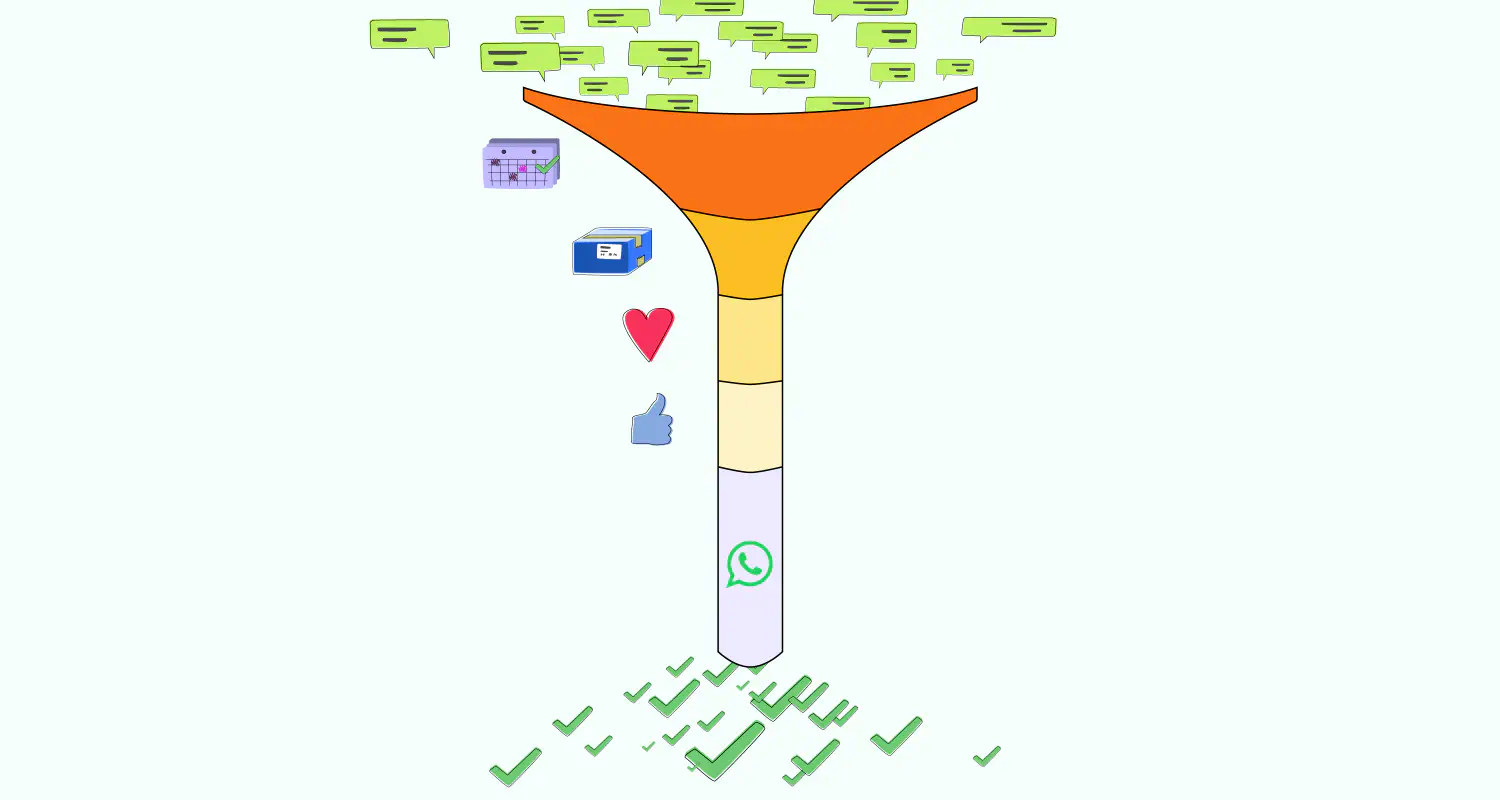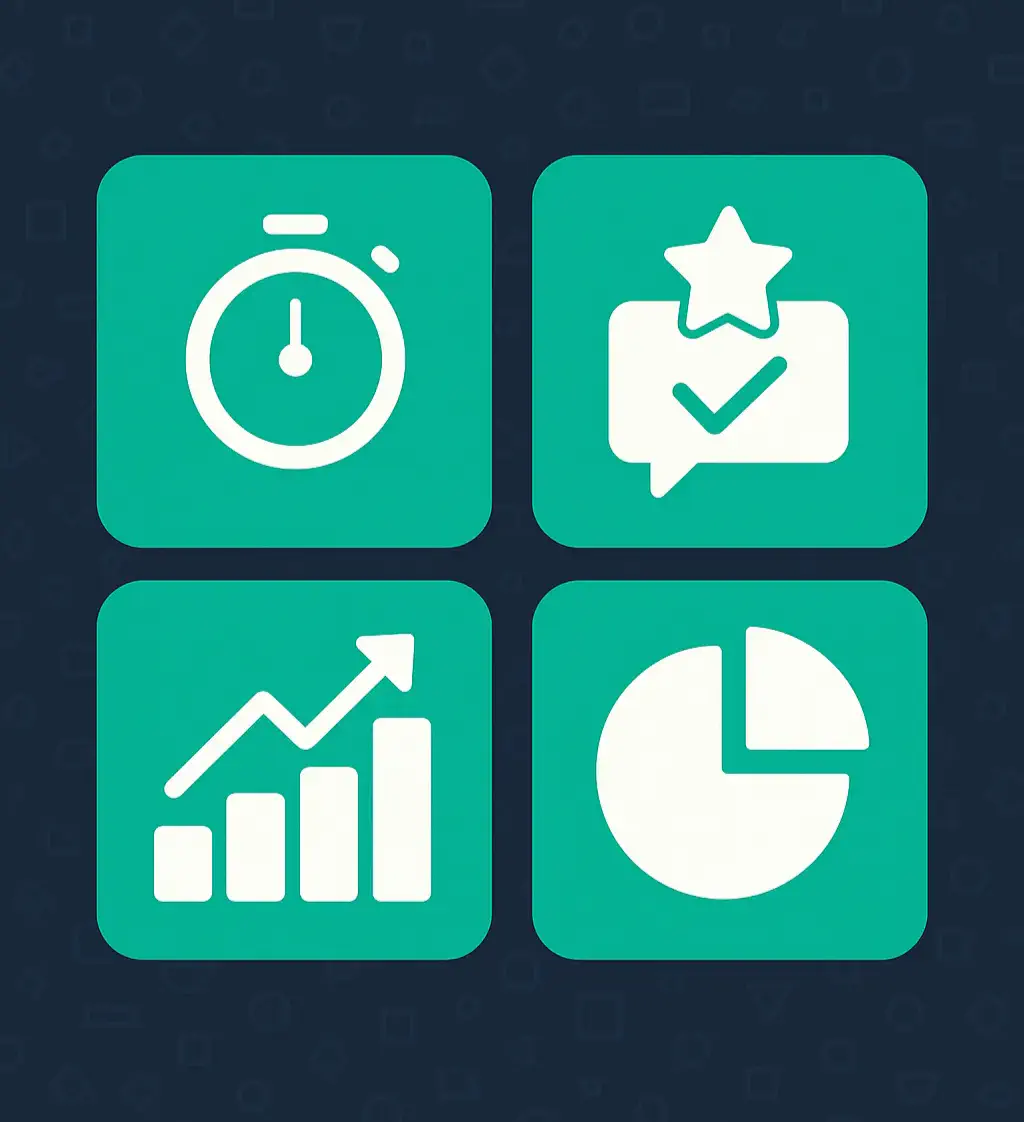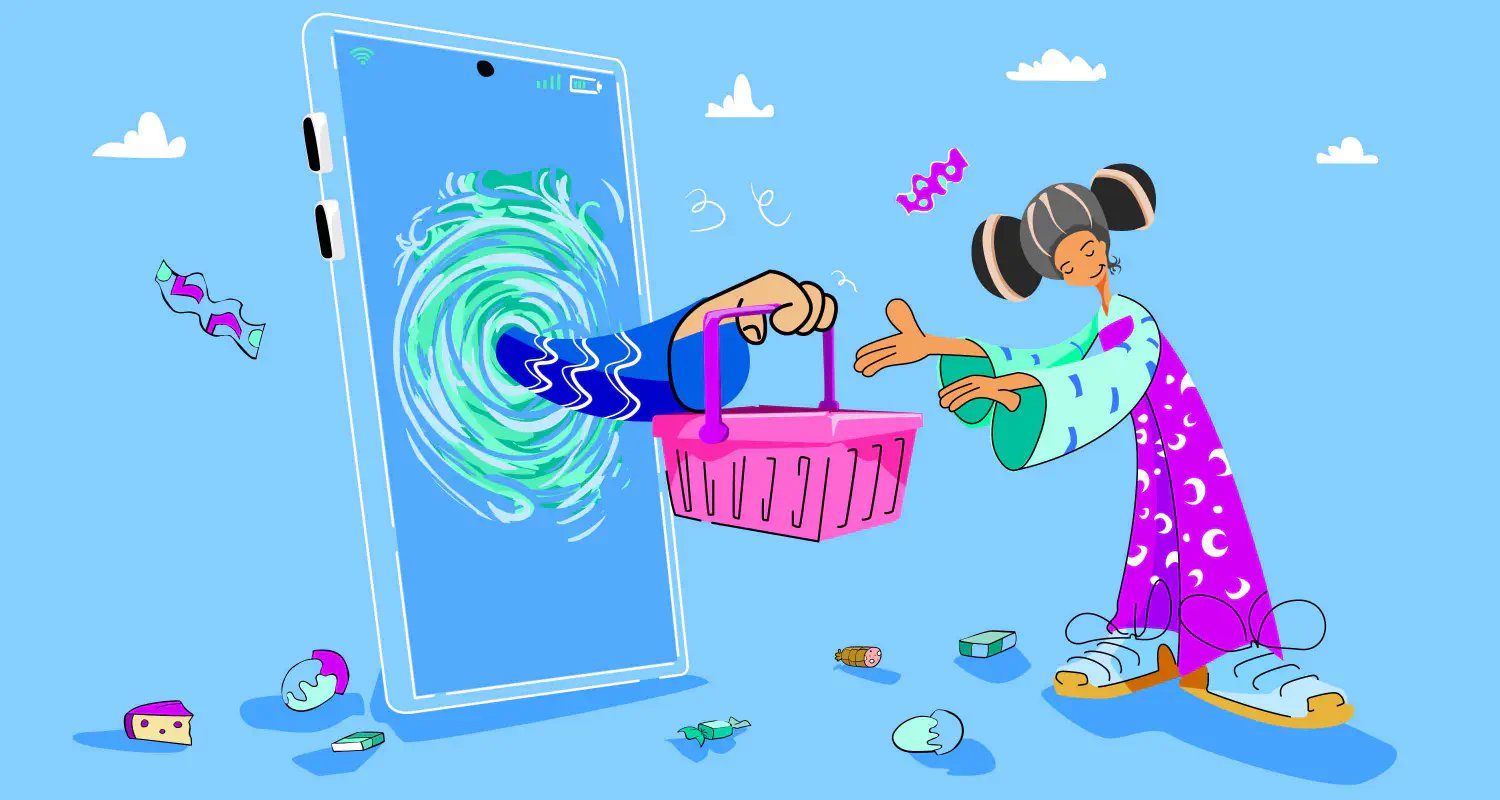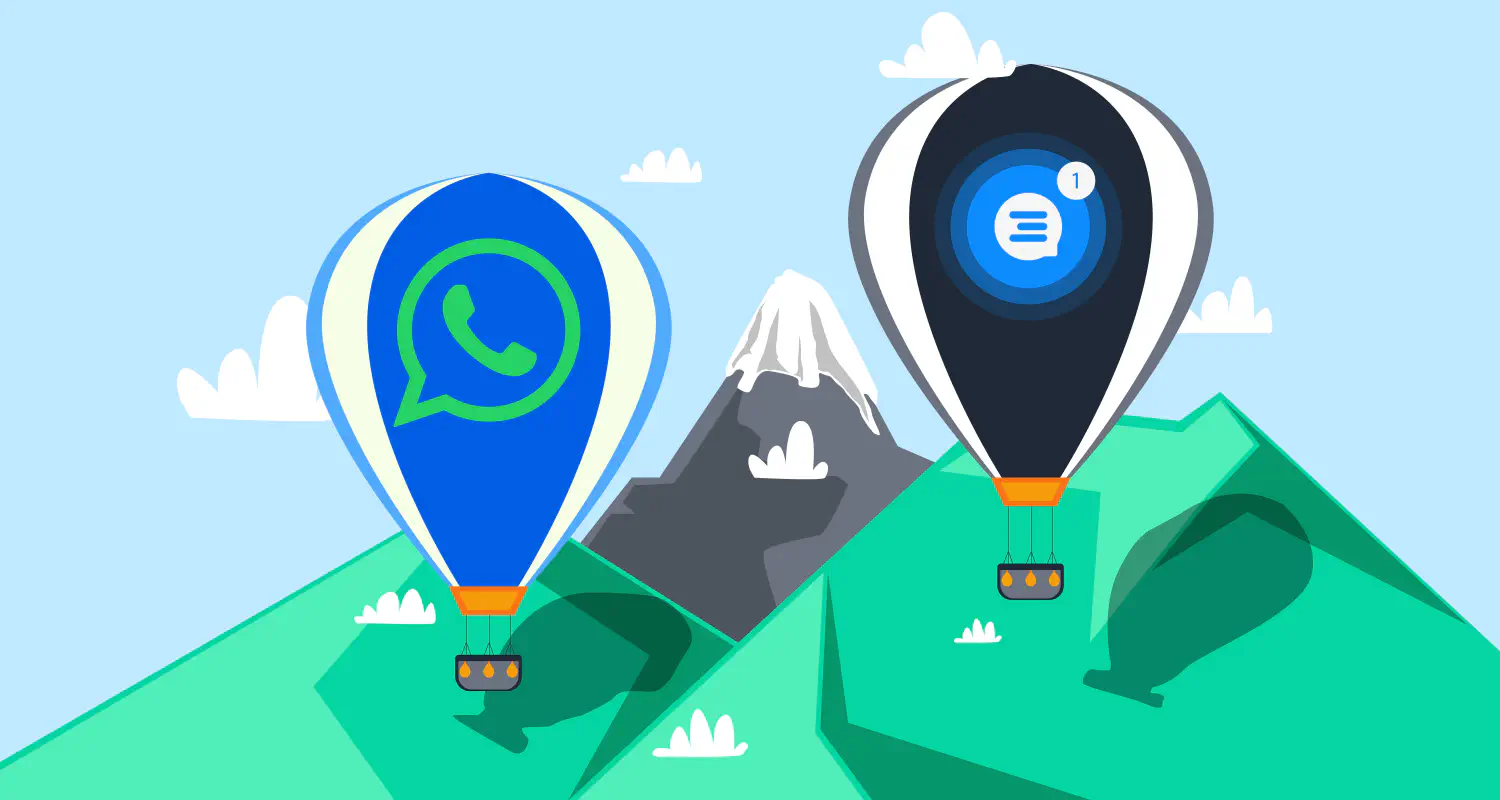How to Design a Customer Service Funnel on WhatsApp

Designing a customer service funnel can be challenging. Most companies stitch together multiple tools—emails, forms, helpdesks—hoping to create a smooth experience.
But what often happens is the opposite: The steps get scattered across different tools, the experience becomes inconsistent for customers, and the teams struggle to stay responsive at scale.
This leads to lower customer satisfaction and retention, which is the main goal of a support process.
The solution? Build your funnel somewhere built for centralized and scalable communication, like WhatsApp.
In this article, we’ll show you how to design a customer support funnel on WhatsApp, why you need it, and what tools can help you.
What is a customer service funnel?
A customer support funnel is a multi-step process that businesses use to guide customers after they become users of the product. The steps include:
- Onboarding: Customers need guidance on what to do after signing up or making a purchase.
- Post-sales support: When customers face an issue while using your product, they need a clear process they can follow to solve it.
- Retention: Customer might go quiet and eventually churn without proactive check-ins or continued value.
- Advocacy: Even your happiest customers won’t advocate for you unless you make it easy (and worth it) for them.
The customer support steps take place after the marketing and sales funnel ends. If done successfully, it should boost customer loyalty and retention.
What tools do you need to build a customer support flow?
To build a strong customer support flow, you need the right tools working together.
Here’s what you need for building a flow that guides customers from onboarding to advocacy:
- CRM integrations to connect conversations with customer data during onboarding and trigger personalized follow-ups for retention.
- Analytics dashboards to measure your team’s performance during post-sale support and the rest of the funnel.
- Automation platforms to handle repetitive tasks and maintain speed at scale. They send onboarding messages, escalate complex issues to agents, and follow up after resolution.
Instead of constantly switching between these tools, more B2B businesses are turning to WhatsApp as a single, centralized support channel. When integrated with these tools, it gives you one single platform where you can manage your entire funnel.
It’s fast, familiar, and mobile-first, making it easier to deliver timely, personalized support where your customers already are.
Why build a customer support process on WhatsApp
Scattered tools, slow responses, and disconnected conversations. These are the reasons customer support often breaks down.
That’s why more businesses are building their entire support process on WhatsApp. It brings every stage into one conversation and one platform.
Here are some benefits of building a support funnel on WhatsApp.
Scalability
As your customer base grows, so do the support requests. WhatsApp helps you scale by allowing a mix of customer support automation and human interaction, so you can serve more customers without sacrificing the personal experience they expect.
These automation features mean you’ll reply to all your customers the second they contact you. You won’t drop conversations because the team is occupied, and even if it happens, you can automate reminders.
Efficiency
Customer support on WhatsApp is much more efficient than on other tools. The real-time nature of the application makes the entire funnel faster.
People might check their emails only during work days, but WhatsApp? Studies show that 83% of WhatsApp users open it daily. This means you’ll resolve issues faster and get more customer satisfaction.
Visibility
WhatsApp gives you better overall visibility of your customer service funnel, especially if you use a shared inbox. Traditional support channels, like email, often lack this point. You don’t know who’s handling what, and to get the customer history, you have to switch to a different tab.
WhatsApp solves this by enabling:
- A shared team inbox so everyone has context and visibility into active conversations.
- Conversation history that stays in one thread, so no need to ask “Can you repeat your issue?”
- Monitoring tools that track resolution time, response rate, handovers, and more.
Personal communication
Support doesn’t have to be too formal or distant. WhatsApp is where everybody talks to their family and friends, so having support there can make your team feel closer and more like a trusted partner than a help desk. This helps you build stronger, longer-lasting customer relationships.
What are the stages of a WhatsApp support funnel?
A well-designed customer support journey on WhatsApp should guide users smoothly and build customer trust and loyalty. It includes four main stages that can all be done on WhatsApp: onboarding, post-sales support, retention, and advocacy.
Here’s our guide to building a WhatsApp customer support funnel.
Onboarding
Onboarding is the process of guiding new customers after they’ve purchased your product so they can start using it as smoothly as possible.
It involves things like:
- Welcoming the customer
- Tutorials on how to get started
- Tips or walkthroughs
- Answering common questions
Here, long silence after purchase or confusing next steps can result in a poor onboarding experience.
Building a a customer support process on WhatsApp lets you guide customers in real time. You can space out helpful check-ins across the first week and answer setup questions instantly. It also offers automation so that your team doesn’t respond to each message manually.
You can learn how to design better onboarding flows for your customers here.
Post-sales support
Post-sales support is the support you provide to customers after they’ve purchased your product or service.
It often includes:
- Troubleshooting technical issues
- Answering product-related questions
- Processing returns, replacements, or upgrades
Thing is, if customers wait too long or feel ignored, especially when using tickets or email, you’ll likely end up with dissatisfied customers and higher customer churn.
But it doesn’t have to be this way—simply because you can use WhatsApp! Its fast and real-time conversational nature helps you acknowledge issues fast and resolve them while maintaining a personal tone that builds trust. Also, its automation features help you scale your customer support efforts without overwhelming your team.
Retention
Retention is the stage in the customer journey that keeps customers engaged and satisfied with your product, even after a while of purchasing.
Retention can include:
- Regular follow-ups
- Sharing helpful tips, updates, or best practices
- Making sure customers are still achieving their goals with your product
A common issue businesses overlook is letting the customer relationship fade after onboarding, especially in long contract cycles.
Here. having a well-structured WhatsApp customer service funnel lets you maintain a continuous presence, sharing tips or highlighting underused features. You can schedule automatic reminders and messages to be sent every once in a while to keep the customers engaged. Not to mention, you create a channel that customers actually notice and respond to instead of relying on mass emails.
Advocacy
Advocacy is the stage where you encourage customers to promote your product and recommend it to others. This could be through referrals, testimonials, reviews, or simply recommending your brand to peers.
This stage often involves:
- Asking happy customers to leave reviews or ratings
- Encouraging referrals through formal programs or informal asks
- Turning loyal users into case study participants or brand ambassadors
A common pitfall here is that businesses rarely ask for feedback or referrals at the right time. But because the conversation is already warm and ongoing, asking for a testimonial, rating, or referral on WhatsApp doesn’t feel intrusive. In other words, building a support funnel on WhatsApp helps you schedule your follow-ups and keep advocacy efforts consistent, without needing to manually track every opportunity.
What metrics do you need to track in your customer support funnel?

To build a high-performing customer care funnel on WhatsApp, tracking the right metrics is just as important as designing the right flows.
Metrics help you spot gaps, improve team performance, and create better customer experiences that drive real business results.
Here’s what you need to track:
- First response time (FRT) and first contact resolution (FCR) to see how quickly your team replies and how often issues are resolved in one go.
- Customer satisfaction metrics on WhatsApp, like NPS and CSAT, to know whether your customer support experience can build trust and loyalty.
- Key indicators of deal momentum in WhatsApp conversations. For instance, average resolution time and first response rates to spot where conversations are stalling.
- Essential WhatsApp KPIs across the entire support journey, like conversation volume, response time, resolution rate, and handover count, to build a clear, full-funnel view of performance.
If you want to understand how support performance affects revenue, check out our article on 5 ways WhatsApp analytics can boost your sales conversion rates.
Conclusion
Traditional customer support processes are often slow and too scattered. Teams use too many tools, and customers are forced to repeat themselves.
As businesses grow, these gaps only widen. That’s why companies are reimagining support, starting with the channel itself. They’re starting to adopt WhatsApp as a support channel for its real-time nature and possible integrations.
Designing a clear, structured support process flow on WhatsApp helps you guide your customers from onboarding to advocacy with less friction, faster responses, and a more personalized experience.

Hania is a seasoned researcher and content writer specializing in WhatsApp Business and its role in B2B sales and customer engagement. With years of experience creating in-depth, thought-provoking content, she combines real-life use cases and deep industry insights to help businesses leverage WhatsApp as a growth tool. Her expertise lies in translating complex research into actionable strategies, making her a trusted resource for companies looking to innovate their communication and sales processes.





